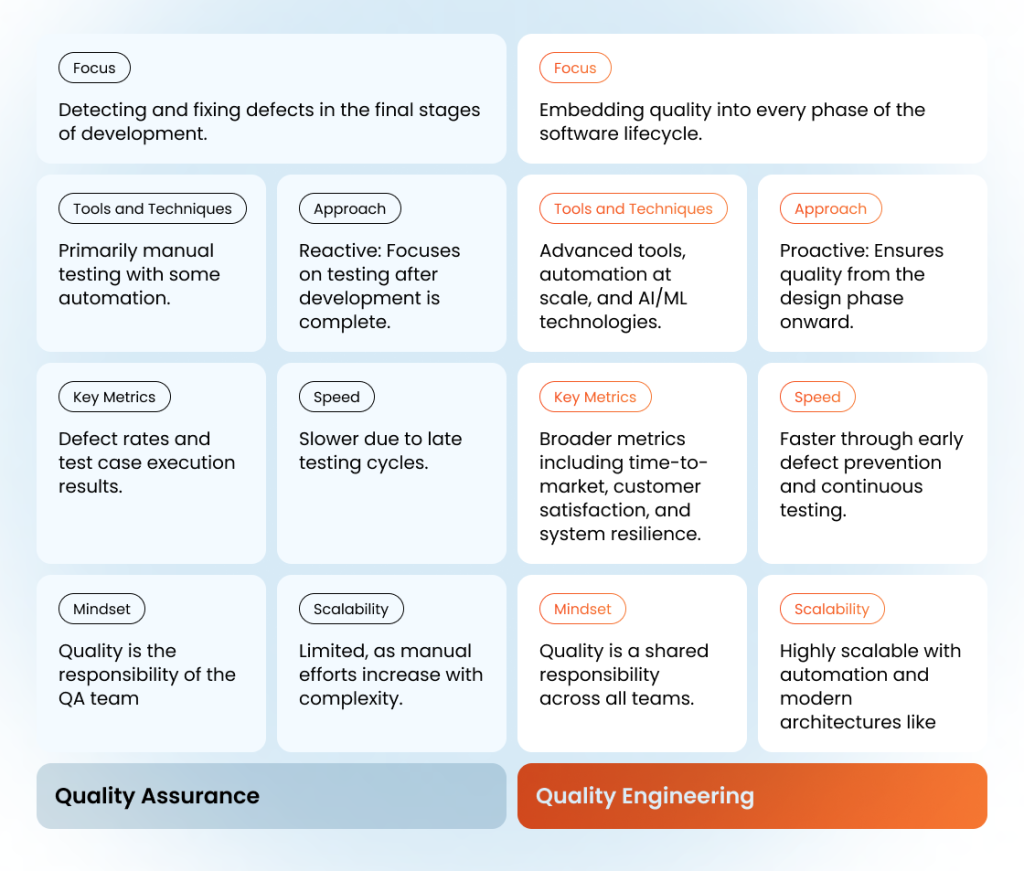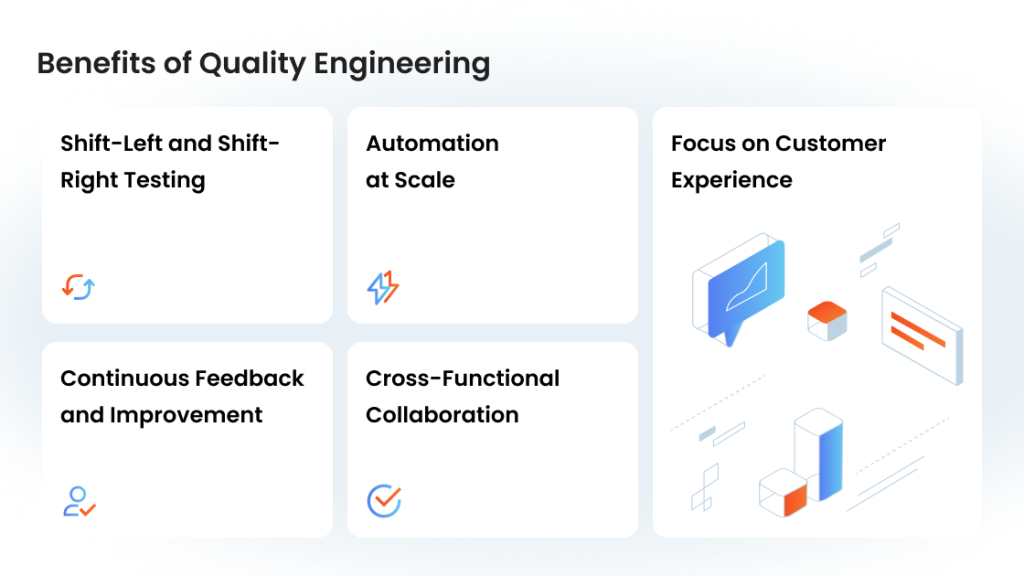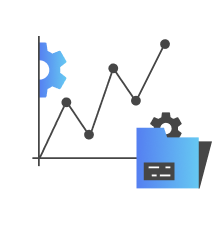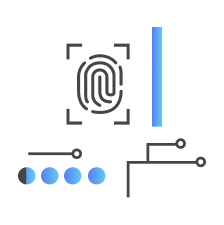In a market saturated with all kinds of software imaginable, users understandably want strong functionality, a unique selling proposition, and a positive brand reputation. However, none of those things will matter much if the software doesn’t meet the quality expectations of the users.
Throughout the history of software, timely testing and quality assurance have been the most ubiquitous ways of ensuring that the product was free of flaws before its release. Still, that technique only makes it possible to detect existing issues in the software. After searching for an approach that would prevent defects rather than identify them, the software industry came up with quality engineering. And even though QE has been around since the early 2000s, it remains a novelty concept for many teams.
So, what is quality engineering, how does it benefit the development process and the final product, and how to implement QE practices in your workflow? In today’s article, we will answer those questions and more.
Key Takeaways
- Quality engineering (QE) is a proactive approach that prevents defects by embedding quality practices throughout the software development lifecycle, from design to deployment and maintenance.
- Unlike traditional QA that focuses on end-stage testing, QE emphasizes prevention over detection, creating a continuous quality loop through automation, cross-functional collaboration, and early integration.
- QE improves software quality through shift-left and shift-right testing, automation at scale, continuous feedback loops, cross-functional collaboration, and customer experience focus.
- The approach particularly benefits enterprise software, eCommerce, healthcare, fintech, IoT systems, and cloud/SaaS solutions requiring complex architectures and regulatory compliance.
- QE supports digital transformation by enabling agility through DevOps integration, enhancing automation, supporting modern cloud architectures, and minimizing risks through early defect detection.
- Organizations should transition from QA to QE to build quality into every stage, address increasing complexity, align with business outcomes, and strengthen competitive advantage.
- Successful QE adoption requires quality culture, established DevOps/Agile principles, modern automation tools, team training, defined metrics, and scalable processes.
- The transition involves evaluating current workflows, setting clear objectives, adopting appropriate tools, investing in training, and implementing QE incrementally through pilot projects.
- Common challenges include skill gaps, cultural resistance, tool overload, and success measurement — addressable through structured training, leadership support, and clear frameworks.
- Organizations can leverage outsourced QE partners when lacking expertise, facing deadlines, operating with limited budgets, needing fresh perspectives, or handling high-stakes projects.
What is Quality Engineering?
Quality engineering, or QE, is a proactive approach to ensuring software quality throughout its entire lifecycle, integrating quality practices at every stage — from design and software development to deployment and maintenance.
Unlike traditional quality assurance, which focuses primarily on end-stage testing, QE emphasizes prevention over detection. It combines engineering principles, automation, and cross-functional collaboration to build quality into products from the outset instead of detecting and removing software defects later in the development lifecycle.
Quality engineering is a flexible, versatile approach that can be applied across industries and scenarios where software plays a critical role. However, there are industries where QE’s adaptability makes it an especially valuable asset:
- Enterprise software development. Here, QE helps ensure robust performance and scalability for ERP, CRM, and custom business solutions.
- eCommerce and retail. Optimizing website speed, functionality, and user experience during peak traffic all becomes possible thanks to quality engineering.
- Healthcare and fintech. For these software products, quality engineering assists in ensuring compliance with strict security, privacy, and regulatory requirements.
- IoT and embedded systems. A consistent QA approach helps guarantee the reliability of interconnected devices like smart home systems, wearables, or self-driving cars.
- Cloud and SaaS solutions: Ensuring the quality, performance, scalability, and seamless deployment in cloud-based environments is the primary task of QE for these products.
Let us upgrade your software products with quality engineering
Quality Engineering and Quality Assurance: How Are They Different?
Both software quality engineering and assurance were designed with the same goal in mind: to produce high-quality, reliable products that meet the requirements of their prospective users and stakeholders. However, software QA and QA have different principles, approaches, and procedures, which allows us to easily identify the differences between the two. Here are the key ways in which software QE and QA are different.

How QE Improves Quality of Software
Before we talk about the strategies for implementing quality assurance engineering, let’s find out what this approach can do for you and how exactly it impacts the quality of your product. Here are the five primary ways in which proper quality engineering practices transform the state of software.
1. Shift-Left and Shift-Right Testing
Quality engineering improves software quality by combining shift-left and shift-right testing approaches:
- Shift-left testing emphasizes early defect detection by integrating testing into the development phase, preventing issues before they escalate.
- Shift-right testing focuses on post-deployment monitoring and validation, ensuring software performs well in real-world scenarios.
Together, these approaches create a continuous quality loop, minimizing risks while optimizing performance and reliability. For example, unit test automation during development (shift-left) and production monitoring tools (shift-right) work jointly to address quality throughout the entire software lifecycle.
2. Automation at Scale
Automation at scale is a cornerstone of quality engineering, enabling faster and more reliable testing. Quality engineering automation primarily includes repetitive tasks, such as regression tests, performance checks, and security testing, using tools like Selenium, Appium, and Cypress. This reduces human error and accelerates feedback loops.
At scale, QE automation also speeds up the continuous integration and continuous deployment pipelines, allowing teams to write and execute thousands of test cases across a variety of environments seamlessly. Automation frees up testers for exploratory testing and helps deliver high-quality software even under the tight deadlines of a modern development cycle.
3. Continuous Feedback and Improvement
Quality engineering relies on continuous feedback to identify potential defects and resolve issues quickly. Monitoring tools and analytics capture real-time data from testing and production environments, providing actionable insights.
For example, performance monitoring can reveal bottlenecks in a live system, enabling rapid fixes. Feedback loops also extend to users through surveys or usage analytics, which inform future development priorities. By fostering a culture of ongoing improvement, QE ensures the software evolves to meet user needs and maintains high standards.
4. Cross-Functional Collaboration
Quality engineering thrives on collaboration between development, QA, operations, and business teams. Cross-functional team communication breaks down bottlenecks, allowing teams to align on quality goals and share responsibilities.
How exactly does this work?
Cross-team collaboration typically looks like this: developers write tests, QA specialists implement automation, and operations teams provide real-time monitoring data. Collaboration tools like Jira, Slack, or Azure DevOps support this integration, making workflows transparent and efficient. By promoting teamwork, QE ensures that quality is everyone’s responsibility, leading to effective defect prevention, faster issue resolution, and improved processes.
5. Focus on Customer Experience
Quality engineering prioritizes the end-user experience by embedding customer-centric principles and practices into development. It ensures that usability, performance, and functionality align with user expectations. Techniques like usability testing, accessibility compliance, and real-time monitoring help identify pain points and improve satisfaction.
For example, teams in charge of the QE process might use A/B testing to determine which interface design resonates best with users. This focus on the customer not only enhances the product but also drives loyalty and trust, setting the software apart in the competitive market.

Make the most of quality engineering with our expertise
How Quality Engineering Supports Digital Transformation
Digital transformation is a crucial step for organizations that want to take advantage of modern technology, upgrade their operations, and improve the software delivery process at all stages. With the right quality engineering approach, digital transformation can happen faster and produce even better outcomes. This is how QE supports digital transformation.
1. Enabling Agility and Speed
Quality engineering integrates with Agile and DevOps, enabling faster development cycles. Continuous testing ensures high-quality software is delivered quickly, allowing businesses to adapt to market changes and reach digital transformation goals efficiently.
2. Enhancing Automation
Automation reduces manual effort and accelerates testing processes. By ensuring consistent results across systems, quality engineering allows teams to focus on innovation, streamlining development, and boosting the efficiency of digital transformation efforts.
3. Supporting Cloud and Modern Architectures
Quality engineering ensures resilience, scalability, and security in cloud-based, microservices, and serverless architectures. By evaluating performance and addressing complexities, it supports organizations in adopting and optimizing modern technologies effectively.
4. Minimizing Risks
Shift-left testing detects issues early, reducing costly production failures. Quality engineering ensures compliance with standards, providing comprehensive testing coverage to minimize risks and enhance the reliability of digital transformation efforts.
Why Should You Go from QA to QE?
For decades, quality assurance has been the most common way to ensure that quality standards are fully adhered to in new software products. Now, as quality engineering is generating more and more buzz online, organizations of all calibers will inevitably need to decide whether they are completely satisfied with their current quality assurance processes or want to unlock a new page in the software quality book by adopting QE practices. Here are 5 reasons to go for quality engineering.
1. Building Quality into Every Stage
QE shifts the mindset from testing quality at the end of development to embedding quality practices starting early in the development process. By integrating quality from the design stage and maintaining it throughout the entire development cycle, companies can prevent defects rather than simply identifying them later.
2. Addressing Increasing Complexity
Modern software systems are getting increasingly more complex, incorporating AI, IoT, and cloud environments. Quality engineering is equipped to handle this complexity by utilizing advanced tools and frameworks, analytics, and automation to ensure performance, scalability, and security across diverse architectures.
3. Aligning with Business Outcomes
Unlike traditional QA, which focuses primarily on technical metrics, QE emphasizes aligning quality practices with business objectives. This means delivering software that not only meets technical requirements but also drives customer satisfaction, market differentiation, and revenue growth.
4. Supporting Innovation and Scalability
Quality engineering fosters a culture of innovation by enabling rapid experimentation through automation and continuous feedback. This scalability is critical for companies aiming to expand their offerings or respond quickly to market opportunities.
5. Strengthening Competitive Advantage
In competitive industries, quality engineering takes on an even more crucial role as it ensures faster time-to-market, seamless user experience, and consistent product quality. These advantages allow companies to stay ahead by meeting evolving customer expectations and outperforming competitors.
From more reliable software to market recognition — you can have it all with quality engineering
Who Can Adopt Quality Engineering Testing?
After testing software the traditional way for years, the switch to quality engineering may seem daunting, especially when it feels like you have to overhaul your entire software development process before you can even attempt that.
In reality, however, the shift is not that monumental as long as you already have some established QA practices in place and can realistically meet the following criteria before integrating quality engineering into your development process:
- Fostering a culture of quality. Project leaders must prioritize quality at every stage, establishing collaboration between development, QA, and other operations to achieve consistency across the company.
- Established development principles. Adoption of DevOps, Agile, or CI/CD pipelines provides a foundation for quality engineering by supporting continuous testing and validation, as well as regular code integration.
- Access to modern tools and technologies. The effectiveness of quality engineering depends, among other things, on automation frameworks, monitoring tools, and AI/ML solutions for predictive testing and real-time feedback.
- Training and knowledge sharing. Software teams should understand QE principles like automation and analytics. Training or hiring specialists with relevant experience plays a crucial role in addressing knowledge gaps.
- Defined quality metrics and goals. Clear KPIs such as defect rates and release reliability help measure progress, aligning quality efforts with business objectives all across the QA process.
- Scalable and adaptable processes. Flexible workflows ensure QE adapts to changing requirements and supports complex, scalable systems effectively, which is critical for modern software solutions.
How to Transition from Quality Assurance to Quality Engineering
Establishing a finely tuned process within quality engineering principles takes both time and effort. To make sure the transformation does not stall and deliver the anticipated results, follow these steps.
1. Evaluate Your Current Processes
Start by assessing your existing workflows within software development and testing, identifying inefficiencies, and analyzing gaps. This evaluation helps understand where your organization stands and what needs improvement to move toward a more proactive QE approach. Key areas to evaluate include:
- Testing coverage and efficiency.
- Integration with development and operations teams.
- Automation maturity and tool usage.
2. Set Clear Objectives
At this stage, you will need to define measurable goals for the transition that are aligned with business outcomes. These goals ensure your QE transformation matches your organizational priorities. Objectives here may include:
- Reducing defect rates or time-to-market.
- Improving customer satisfaction through better quality.
- Increasing automation coverage.
3. Adopt the Right Tools and Technologies
Equip your teams with tools that support automation, monitoring, and collaboration. The right tools enable seamless integration of QE into development and operations. Consider adding the following tools to your roster:
- Test automation frameworks like Selenium or Cypress.
- CI/CD tools like Jenkins or Azure DevOps.
- AI/ML-driven testing solutions for advanced analytics.
4. Invest in Skills and Training
One of the most common bottlenecks product owners and technical managers face on the way to QE adoption is the lack of necessary skills within the team. This is why it’s necessary to train your teams to embrace QE practices. Focus on:
- Automation scripting and coding.
- DevOps and CI/CD workflows.
- Data-driven testing and analytics.
5. Implement QE Incrementally
Even though it can be tempting to adopt quality engineering as quickly as possible, a drastic change will not benefit either the process or the team. Incremental implementation, on the other hand, ensures minimal disruption and sustainable adoption. Transitioning to QE is best achieved step by step:
- Start with small pilot projects to validate processes.
- Gradually expand QE practices to other teams and projects.
- Monitor progress using metrics like defect density and cycle time.
We will make the quality of your software its standout feature
Challenges of Adopting QA and How to Overcome Them
Implementing software QA engineering as the primary testing practice within an organization requires a dedicated approach and careful planning. However, even with the most thoughtful shift procedure in place, some challenges and complications are nearly inevitable. Here are the biggest challenges prospective quality engineers need to be aware of.
1. Skill Gaps
Transitioning to quality engineering requires specialized skills in automation, DevOps, and advanced testing tools. Many team members may lack expertise in coding or scripting, have limited familiarity with QE-specific tools and methodologies, or present challenges in recruiting professionals with relevant skills.
How to overcome: Organizations can address this challenge by investing in structured training programs, offering certifications, and creating mentorship opportunities while recruiting experienced QE experts to guide teams.
2. Cultural Shift
Quality engineering demands a significant mindset shift from reactive QA to proactive quality ownership. Resistance to change from traditional QA teams, a lack of cross-functional collaboration, and misalignment in priorities among development, QA, and operations teams often hinder progress.
How to overcome: Encouraging open communication, cross-functional team-building activities, and firm leadership for QE practices can foster a shared responsibility for quality across teams.
3. Tool Overload
Adopting quality engineering can sometimes lead to over-reliance on tools, which can cause inefficiencies. This happens when organizations struggle to select appropriate tools from a vast market, face integration and compatibility issues, or overcomplicate workflows with unnecessary tools.
How to overcome: Companies should focus on assessing and picking tools based on their needs, standardizing tool usage, and ensuring they integrate smoothly into existing workflows for simplicity and efficiency.
4. Evaluating Success
Measuring the impact of QE initiatives can be complex, especially when defining relevant KPIs such as defect density or time-to-market. Balancing short-term metrics with long-term quality goals and ensuring meaningful insights from collected data add to the challenge.
How to overcome: Establishing clear evaluation frameworks, regularly revisiting KPIs, and using analytics tools to derive actionable insights can help track and refine QE efforts effectively.
Partnering to Deliver Quality Software
Building a QE testing process in-house from the ground up is usually the preferable option. However, it’s not always feasible or even realistic. At the same time, outsourced quality engineering has been lately gaining traction as an accessible, less resource-intensive way to implement quality engineering in software development. Here is how it works and whether it’s the right choice for you.
When to Opt for an Outside QE Partner
Making a switch to quality engineering in software testing is a move that will likely transform the whole quality assurance paradigm within your organization. There is obviously a lot riding on the correct implementation of the new practices, but you don’t necessarily have to go through the entire transformation alone. Here are the main reasons why outsourced software quality engineering solutions may be exactly what you need to get your products to the next level of finesse:
- Lack of in-house expertise. If your team lacks experience with QE practices, tools, or methodologies, outsourcing can provide immediate access to skilled professionals with proven expertise in automation, DevOps, and shift-left testing.
- Tight deadlines. When the company faces time constraints or an increased project workload, outsourcing helps scale efforts quickly, ensuring quality standards without putting too much strain on internal teams.
- Limited budget. Building an in-house quality QE team involves significant investment in tools and training. Outsourcing can reduce costs by using the partner’s existing infrastructure and expertise.
- Fresh perspective. External partners bring industry knowledge, best practices, and innovative ideas, helping you identify inefficiencies and optimize processes more effectively than internal teams because, unlike your developers, they don’t have any personal attachment to the product.
- High-stakes project. For mission-critical systems or compliance-heavy industries like healthcare and fintech, outsourcing ensures that experienced specialists handle the rigorous quality requirements using their vast prior expertise instead of learning as they go.
What to Look for in a QE Vendor
With software quality engineering quickly gaining popularity as a superior way to ensure that every aspect of the software development process has a positive impact on its quality, you can see more and more vendors advertising their quality engineering teams and services online. However, if you want your quality engineering efforts to pay off in the end, it’s important to approach the choice of a vendor with as much care as you would approach hiring a C-level team member. Here are a few things to look for in an outsourced quality engineering partner:
- Technical skills and proficiency with tools. Look for a partner with extensive experience in QE methodologies, including automated testing, shift-left testing, DevOps practices, and CI/CD integration. They should also be proficient in tools like Selenium, Appium, Jenkins, and AI-driven testing platforms.
- Relevant industry experience. A partner with a proven track record in your industry understands domain-specific challenges, compliance requirements, and best practices. For example, a fintech-focused partner will know the importance of security and regulatory compliance.
- Proven success record. Request case studies, client testimonials, or metrics showing their impact on past projects. Look for tangible outcomes like reduced defect rates, faster time-to-market, or improved user satisfaction.
- Scalable and flexible approach. The partner should be capable of scaling their resources up or down to meet your project demands. Moreover, your potential partner should tailor their approach to your organization’s goals, culture, and existing workflows. Avoid generic, one-size-fits-all solutions.
- Communication and collaboration. Effective communication and seamless collaboration are essential. The partner should integrate smoothly with your team and agree to use modern tools like Slack, Jira, or Microsoft Teams for transparency and accountability.
- Commitment to security and compliance. Make sure your partner follows best practices for data protection and adheres to industry-specific compliance standards, especially for highly regulated sectors like healthcare, finance, or eCommerce.
- Focus on continuous improvement. A strong quality engineering partner emphasizes learning and evolving. They should proactively suggest emerging trends, tools, and strategies, ensuring your processes stay competitive.
Looking for a QE Partner You Can Trust?
Let our Head of Delivery show you a roadmap to success.
The Future of Quality Engineering
Even though QE is already impacting quality measures and testing strategies in countless organizations as we speak, quality engineering as a whole is still in its early development stages and will undoubtedly transform more in the upcoming years. Here are the key factors that will shape the future of quality engineering in the software industry.
AI and ML on Guard of Software Quality
Artificial intelligence and machine learning are set to transform quality engineering more than any other tech trend. These technologies enable predictive analytics, helping identify potential defects before they occur. AI-powered tools can analyze test data, detect patterns, and suggest optimizations, significantly reducing manual effort. ML also facilitates smarter test case generation, prioritization, and self-healing automation scripts.
Moreover, AI can improve performance testing by simulating real-world conditions, while ML-based models help refine user experience through advanced insights. As AI and ML evolve, quality engineering will become faster, more accurate, and highly adaptive to modern software complexities.
Scaling for Growth
As businesses scale, quality engineering must adapt to manage increasing demands. QE ensures that scalability is embedded into software systems by supporting microservices, cloud architectures, and containerized solutions.
Automation will play a crucial role in handling vast amounts of test cases and data across distributed systems. Continuous monitoring and robust pipelines ensure that quality standards are maintained as organizations expand. Scaling QE also requires investing in tools and strategies that can keep up with rapidly growing development cycles and user bases.
Staying Competitive in a Grueling Market
In a constantly changing market, quality engineering gives companies a competitive edge. By ensuring prevention of quality issues and faster delivery of high-quality products, QE supports innovation and differentiation.
Emerging practices like shift-left testing, continuous integration, and user-centric design will remain crucial. Organizations that embrace these practices while staying agile and customer-focused will stand out, retaining loyalty in increasingly demanding markets. Adopting QE ensures that companies can respond to challenges without compromising quality.
Final Thoughts
Testing and quality assurance have always been highly effective ways of delivering reliable software. However, at their core, these practices are reactive and allow teams to detect quality issues after they’ve occurred, whereas QE makes it possible to proactively prevent them from happening in the first place. This is why it’s completely unsurprising that more and more organizations are switching from QA to QE or, at least, implementing some of QE practices into their processes. And while the task of adopting a new approach may seem daunting, the results are going to be more than worth it. Whether on your own or with a partner, we hope that quality engineering takes your software to exactly where you want it to be.
Frequently Asked Questions
 What’s the main difference between Quality Engineering and traditional Quality Assurance?
What’s the main difference between Quality Engineering and traditional Quality Assurance?
Quality Engineering is a proactive approach that prevents defects by embedding quality practices throughout the entire development lifecycle. Traditional QA is reactive, focusing primarily on detecting issues through end-stage testing. QE emphasizes collaboration, automation, and continuous improvement from design to deployment.
 Which organizations benefit most from implementing Quality Engineering?
Which organizations benefit most from implementing Quality Engineering?
QE particularly benefits enterprise software companies, eCommerce platforms, healthcare and fintech organizations with strict compliance requirements. IoT and embedded systems developers, and cloud/SaaS providers also see significant value. Any organization dealing with complex software architectures, regulatory requirements, or scalability challenges can gain from QE practices.
 How should an organization start transitioning from QA to Quality Engineering?
How should an organization start transitioning from QA to Quality Engineering?
Begin by evaluating current testing processes and identifying gaps. Set clear measurable objectives aligned with business goals. Invest in appropriate automation tools and provide team training on QE methodologies. Implement changes incrementally through pilot projects before scaling across the organization. Focus on building a quality-first culture and cross-functional collaboration.
 What are the biggest challenges when adopting Quality Engineering and how can they be overcome?
What are the biggest challenges when adopting Quality Engineering and how can they be overcome?
Main challenges include skill gaps in automation and DevOps, cultural resistance to change, tool integration complexities, and difficulty measuring success. Overcome these through structured training programs and strong leadership support for cultural change. Use careful tool selection based on actual needs. Establish clear KPIs with regular evaluation frameworks.
 When should a company consider outsourcing Quality Engineering instead of building in-house capabilities?
When should a company consider outsourcing Quality Engineering instead of building in-house capabilities?
Consider outsourcing when your team lacks QE expertise or you’re facing tight project deadlines. Limited budget for building internal capabilities is another key factor. You might also need fresh perspectives on existing processes. High-stakes projects requiring specialized compliance knowledge benefit from outsourcing. An experienced QE partner provides immediate access to proven methodologies and advanced tools
Jump to section
Hand over your project to the pros.
Let’s talk about how we can give your project the push it needs to succeed!







